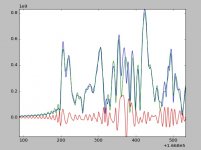I don't have time to explain the obvious in every post that someone otherwise might misconstrue.
Good that you have enough time to spread BS about the superior sound of the 7805 regulator and how painting the inside of a DAC improves the sound. You are very efficient, no question. Good luck with setting up a test valid for 7.5 billion people.
Last edited:
As far as I remember, I realized that it had to be the IC, because everything else in the circuit path was discrete. When I bypassed it, the sound got better.
A very analytic approach, based on "eight legs bad, three legs good"
 .
.what's wrong with the old 7805?Good that you have enough time to spread BS about the superior sound of the 7805 regulator and how painting the inside of a DAC improves the sound. You are very efficient, no question.
what's wrong with the old 7805?
Nothing, it's only noisy as hell, has a crap frequency response, and needs precautions (at the output) to keep it stable. Otherwise, some claim it has special unknown/unmeasurable properties that makes it sound better than a modern LDO regulator when used in a certain DAC model power supply. This conclusion was reached by uncontrolled listening tests and is now considered a "secret sauce" for designing a good DAC.
Quotes available upon request. Which doesn't mean a modern LDO sounds better in that position, only that "if the regulator static and dynamic parameters matter, then a 7805 has absolutely no reason to sound better".
Last edited:
Sorry Pavel but "worse" is no better than "better" as a subjective descriptor, in fact it may be worse, but that's just my opinion of course.
Don't take it so serious. Technically worse, with worse parameters, is often preferred by listening.
Well I am.Not sure anyone is still interested in the last discussion concerning the cymbal soundfile
I don't know why the conversation got so derailed.
I think there was a bit of a clash of the paradigms going on...
In what setting? This is something you've been keeping hidden. Wonder why.The fact remains some people hear it.
Those who shill for audio business tend to use the same playbook.Say you measure hearing ability of 300 people, they are a sample of 300 out of a population of 7.5 billion. What are the chances of randomly selecting 300 test subjects, and having them not be very statistically representative? The chances are extremely high they will not be very representative. (Not to mention the chances you will not correctly measure what you are trying to measure, you may actually be measuring more of something else like the false negative chances of ABX DBT.)
"That´s all" it should be that simple but as history and todays discussions imo show, it is not, as the guard against false negatives is routinely neglected.
I became member of the AES and therefore read some time later the first article by Les Leventhal about the potentially high probability for false negatives when using the then often used ABX tests. New stuff for me (nothing new in the other fields but in these often neglected even up to today) and it became clear that some modifications of the test routine were needed.
It FAILED in that application, and perhaps any similar op amp would also as a substitute for the input buffer.
It failed as in broke or wasn't accepted on the market, sound wise?
If sound-wise, how could you have missed that when auditioning your creation?
//
... If sound-wise, how could you have missed that when auditioning your creation?...
???... not what I have actually designed, even for Parasound.
Is this was the change I notice in the perception of what I call "micro dynamic" ?To my surprise removing the content > 22.05kHz effects the amplitude envelope more than I thought.
Orbited on the outskirts of a black hole.Those who shill for audio business tend to use the same playbook.
May i ask what filter did you use?Here is the magnitude of the two signal envelopes and the difference in red. The Gibbs effect is obvious in the filtered signal but there are differences that are clearly at frequencies well below this.
May i ask what filter did you use?
Full 1920000 point FFT, removing all bins over 22050 kHz and doing the inverse FFT. This gives a "perfect" filter with -300dB out of band and an 0.1Hz transition.
- Status
- Not open for further replies.
- Home
- Member Areas
- The Lounge
- John Curl's Blowtorch preamplifier part IV
